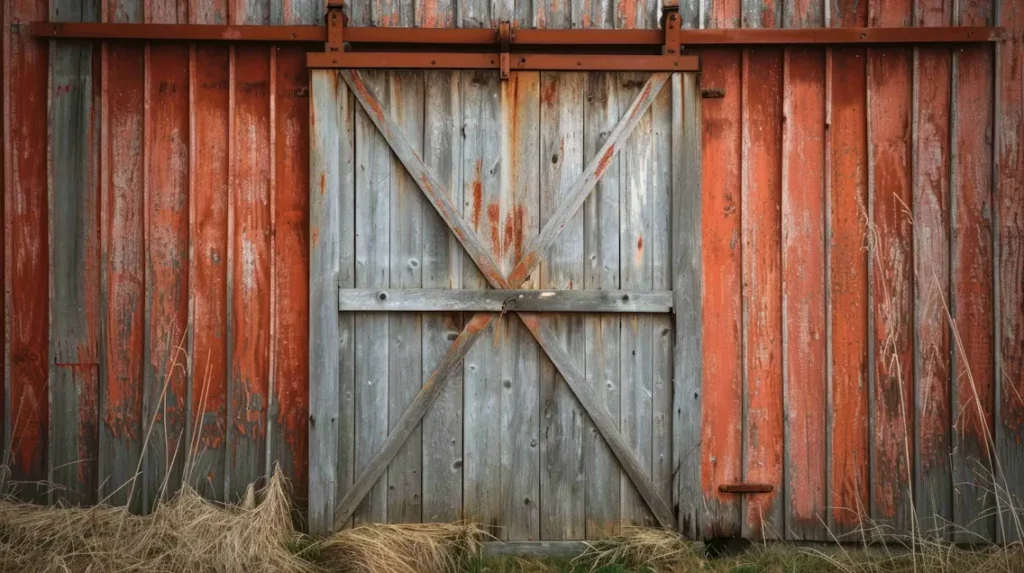Barn doors have a rich history that dates back centuries, originating as functional elements in agricultural settings. Today, they have found new life in modern interior design, blending rustic charm with contemporary aesthetics.

In this article, we will delve into the history of barn doors, their construction, styles, patterns, and how reclaimed barn doors are being repurposed in modern buildings. Additionally, we’ll provide tips on how to find these unique pieces on BarnTraders.com.
The History of Barn Doors
Barn doors were originally designed for practical purposes on farms, providing large openings for livestock and equipment while protecting the interior from the elements. These doors were typically constructed from sturdy wood planks, often sourced from local timber, and reinforced with diagonal braces to withstand heavy use and harsh weather conditions.
Over the years, barn doors evolved in design and construction, reflecting regional architectural styles and available materials. In the 18th and 19th centuries, barn doors were often hand-crafted by skilled carpenters, resulting in unique variations that showcased the craftsmanship of the era.
Types of Barn Door Construction
- Wooden Barn Doors: Traditional wooden barn doors remain popular for their timeless appeal. They are typically made from solid wood planks, such as pine, oak, or reclaimed barn wood. The construction involves joining the planks with horizontal and diagonal braces for added stability.
- Metal Barn Doors: Metal barn doors, often made from steel or aluminum, provide a sleek, industrial look. They are durable and can be powder-coated in various colors to suit different design preferences. Metal doors are ideal for both interior and exterior applications.
Styles and Patterns
Barn doors come in a variety of styles and patterns, each adding a unique touch to the space:
- Classic X-Brace: The X-brace pattern is one of the most recognizable barn door designs. It features a large “X” shape formed by diagonal braces, giving the door a rustic and sturdy appearance.
- Z-Brace: Similar to the X-brace, the Z-brace pattern includes a diagonal brace that runs from one corner to the opposite side, creating a “Z” shape. This design is both functional and visually appealing.
- Chevron and Herringbone: For a more intricate look, chevron and herringbone patterns use angled planks to create a zigzag effect. These patterns add a touch of sophistication and can be customized with different wood stains or paint colors.
- Paneled Barn Doors: Paneled barn doors feature multiple rectangular or square panels, often framed with decorative molding. This style can range from simple and elegant to ornate and detailed, depending on the design.
- Dutch Barn Doors: Dutch barn doors are split horizontally, allowing the top and bottom halves to open independently. This style is perfect for spaces where ventilation is needed without fully opening the door, such as kitchens or nurseries.
Reclaimed Barn Doors: A Sustainable Choice
Reclaimed barn doors are gaining popularity for their eco-friendly and historical appeal. These doors are salvaged from old barns and repurposed for modern use, preserving their unique character and craftsmanship. Using reclaimed barn doors not only adds a touch of history to your home but also promotes sustainability by reducing the demand for new materials.
Historic barns, often built in the 18th and 19th centuries, are a treasure trove of reclaimed wood and architectural elements. These barns were constructed using time-tested methods and high-quality materials, making them ideal candidates for reclamation. The process of reclaiming barn doors involves carefully dismantling the structure, preserving the wood, and repurposing it for new uses.
Reclaimed barn doors can be used in various modern applications:
- Room Dividers: Sliding barn doors are an excellent solution for dividing open spaces without the need for permanent walls. They can be used to separate living areas, home offices, or dining rooms, providing flexibility in how the space is used.
- Closet Doors: Barn doors add a stylish touch to closets, making them a focal point in bedrooms or hallways. Their sliding mechanism saves space compared to traditional swinging doors.
- Bathroom Doors: For a unique and functional bathroom entrance, barn doors offer privacy while adding a rustic or contemporary flair. Frosted glass panels can be used to maintain privacy while allowing light to pass through.
- Pantry Doors: In kitchens, barn doors can be used to conceal pantry shelves, adding a decorative element while keeping the contents hidden. The sliding mechanism also makes it easy to access the pantry without obstructing the kitchen flow.
To find reclaimed barn doors, consider BarnTraders.com. This platform connects buyers with sellers of reclaimed barn doors and other vintage architectural elements, making it easy to find the perfect piece for your project.
Barn doors offer a timeless and versatile design element that can enhance any space. Whether you prefer the rustic charm of wooden doors or the sleek look of metal, there is a barn door style to suit your needs. By exploring different construction methods, styles, and patterns, you can create a unique and functional feature in your home. Additionally, opting for reclaimed barn doors adds a sustainable and historical touch to your decor. For those interested in finding reclaimed barn doors, BarnTraders.com is a valuable resource for sourcing these unique pieces.


Comments